Eight Beat S-134
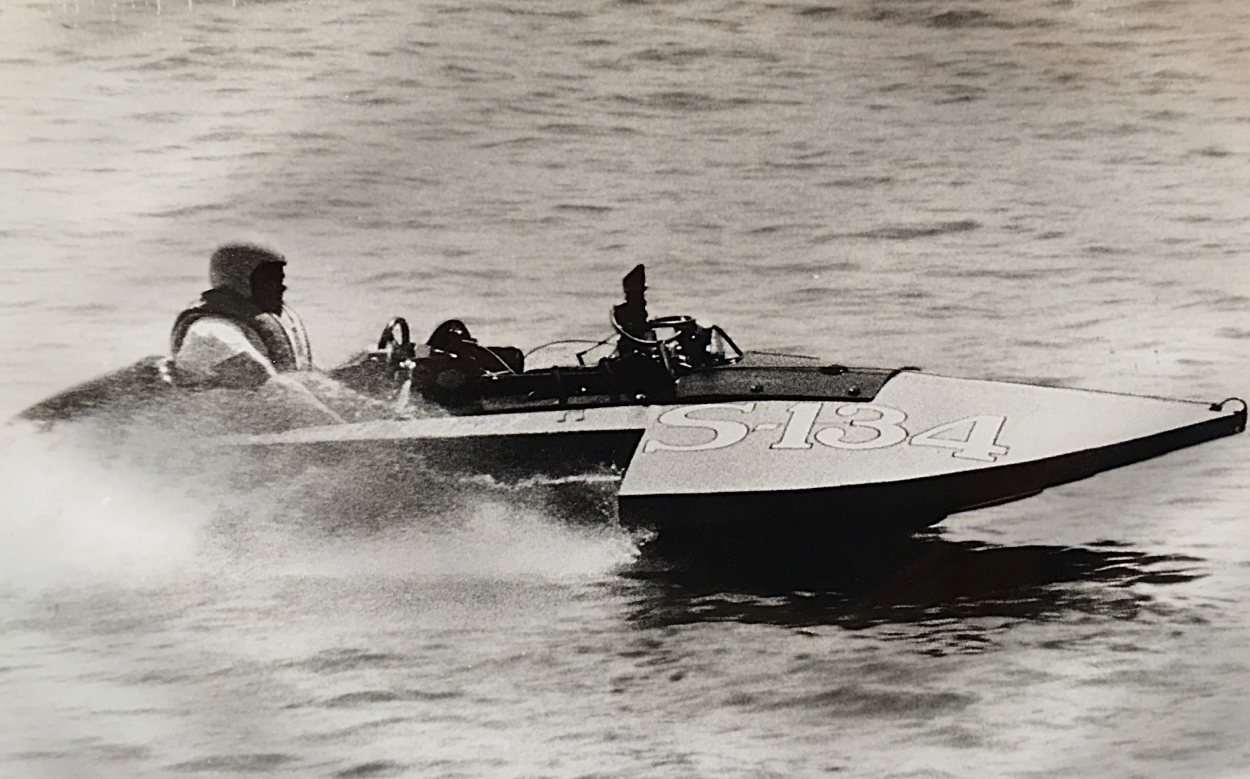
Don Sea owner/driver of S-134 Eight Beat taken
in the 1970s of a rare Tommy Hill built hydro.
Photo
provided by Bob Silva
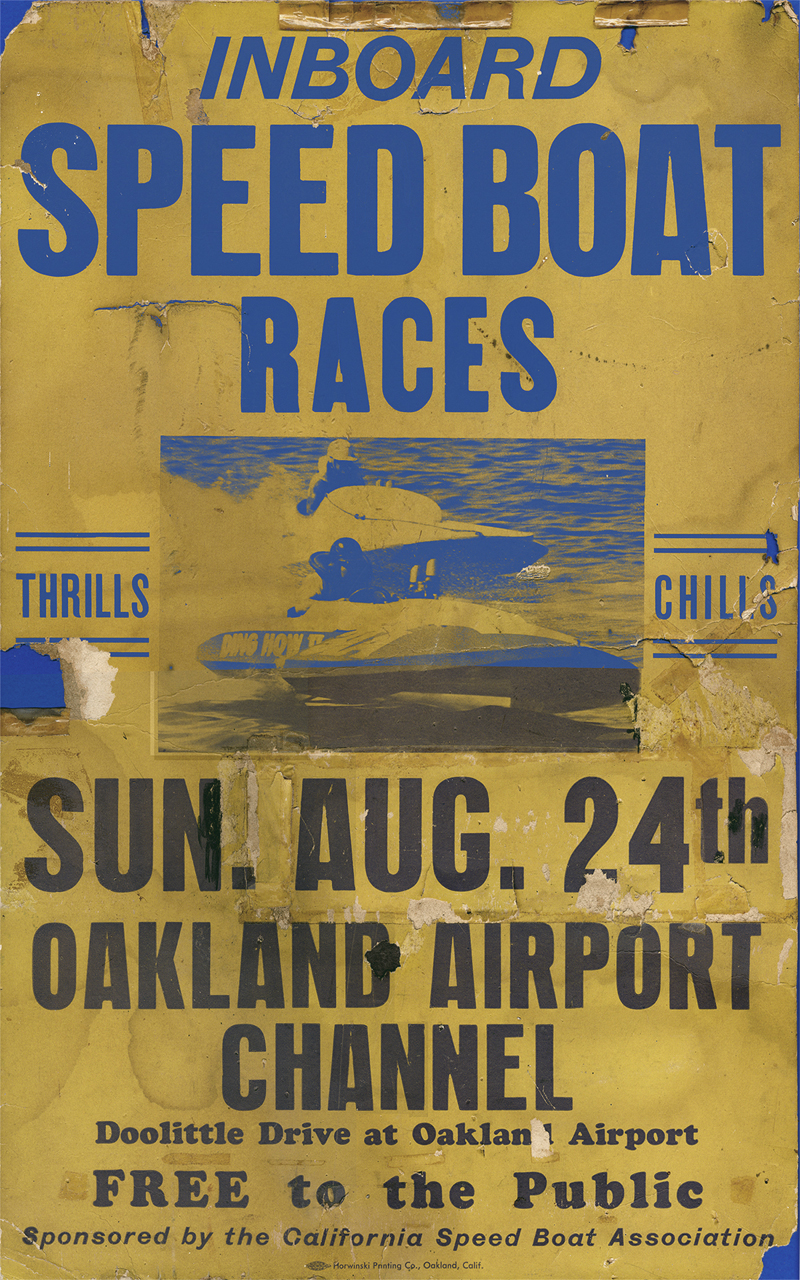
This California Speed Boat Association
poster from a 1952 race features Hart Chan driving his DING HOW II 31-A
Thanks to Bob Silva for taking a
photo of his race
poster
Bob Silva
wrote this
article that appeared in Tom D'Eath's "from the
vintage notebook" March 1996
When I think of early prop riding 3-point
hydroplanes, a West Coast
boat designer/builder and racer comes to mind. His name was Tommy Hill
and the 3-pointers that came out of his Alameda, California shop were
the boats to beat in the 135 and 225 divisions in the mid-1940's.
In
November of 1945, when boat racers returned to the famous Salton Sea,
following World War II, Tommy Hill was there with a Fred Hallett
prepared Ford V8-60 in a 135 hydro of his own design. During the 1 Mile
trials Tommy driving the Ly-Bee,
proceeded to smash the 135 hydro
record by a whopping 27 mph, with an average speed of 80.178 mph. This
speed not only set a record for the 135’s but was also 3 mph faster
than the more powerful 225 Div. 1 class. Following Tommy’s record
breaking performance, an East Coast boat racer, Edison Hedges, bought
the boat on the spot.
In the early 1950’s Hill
retired from active
boat racing and turned his talents to becoming a first rate boat racing
photographer.
Don Sea of Martinez, CA may have the only remaining
Tommy Hill built hull (as of 2007, 2 other Hill boats
have been found since this article was written).
Don found
this boat in 1965 through a classified
Ad in a local paper. The boat had been framed in the basement of an
old house in Oakland, and a wall had to be torn down to remove it. The
deck was burned off and some of the frames charred. The boat sat on an
old junky trailer but still held the V8-60 engine. “My wife thought I
was crazy for buying it”, Don said. “And I covered the boat with a tarp
so the neighbors wouldn’t complain of an eyesore.”
This particular
hull turned-out to be one of Hill’s own racers, and ran as a 135 to
Region II High Points in the late 1940’s. It was later sold to Hart
Chan and renamed Ding
How II 31-A before being campaigned as a 136 called
Lil Miss
Iodine. Then the boat sat in storage for 15 years, until
Sea
found it. Don restored the boat as a 136 hydro, renamed it Eight-Beat,
and ran a stock V8-60 engine. “I also deepened the sponsons to add more
lift, but other than that it’s pretty original,” explained Don.
The
boat raced for several seasons after restoration before he retired it
from racing in the early 1970’s. |
|
BOB SILVA’S WEST COAST REPORT
: SLOW BOAT -- GOOD
COOK
Although he was a native born American, Hart
Chan was known during his time as the only Chinese speedboat driver in
the world. He began racing in the Pacific One Design Hydro
(P.O.D.H.)
class in 1944. He later purchased a Tommy Hill designed 135 hydro and
won
the Region 11 high points for that class in 1948. During the 1953 and
1954
racing seasons he moved into the newly founded 136 cu. in. stock class.
Chan had an endless enthusiasm for boat racing and a wonderful sense of
humor. He named his boats after the restaurant he owned in Oakland,
California
- Ding How, which translates into ““The Best” or
“Number One”. Across
the stern of his red and white boat were the words “The Slow Boat To
China”.
Even the newspaper advertisements for his restaurant said “Slow Boat -
Good Cook”.
In 1957, Chan purchased a 7 Litre Class
Hydro,
hardly a “Slow Boat”
in any sense, the Ding How III. It was powered
by a supercharged 392 Chrysler Hemi. Chan found himself in some real
fast
company in the 7 Litres, including Henry Kaiser’s 32-H,
Restless,
driven by Barney Navarro; the Hallet - Black - Greer team with their 73-H
Seven Grand; and Roger Murphy’s 20-H, Galloping Gael
(which
set a 1 mile record of 131 mph and upped the 5 mile record to 90 mph).
On February 6, 1960, Hart Chan passed
away
after a long illness, at the early age of 46. He left behind
a great
spirit of camaraderie and loved racing for the thrill of the ride.
|
Bob Silva
wrote this
article that appeared in Tom D'Eath's "from the
vintage notebook" August 1995
When the TVH webmaster sent this article to current owner George Smith
he replied back, "Very interesting,
we used to go to a Chinese restaurant in El Cerrito called Ding
How...could it be?
The restaurant was in the East Bay, about 20 minutes from my shop"
S-134
Eight Beat
RESTORATION
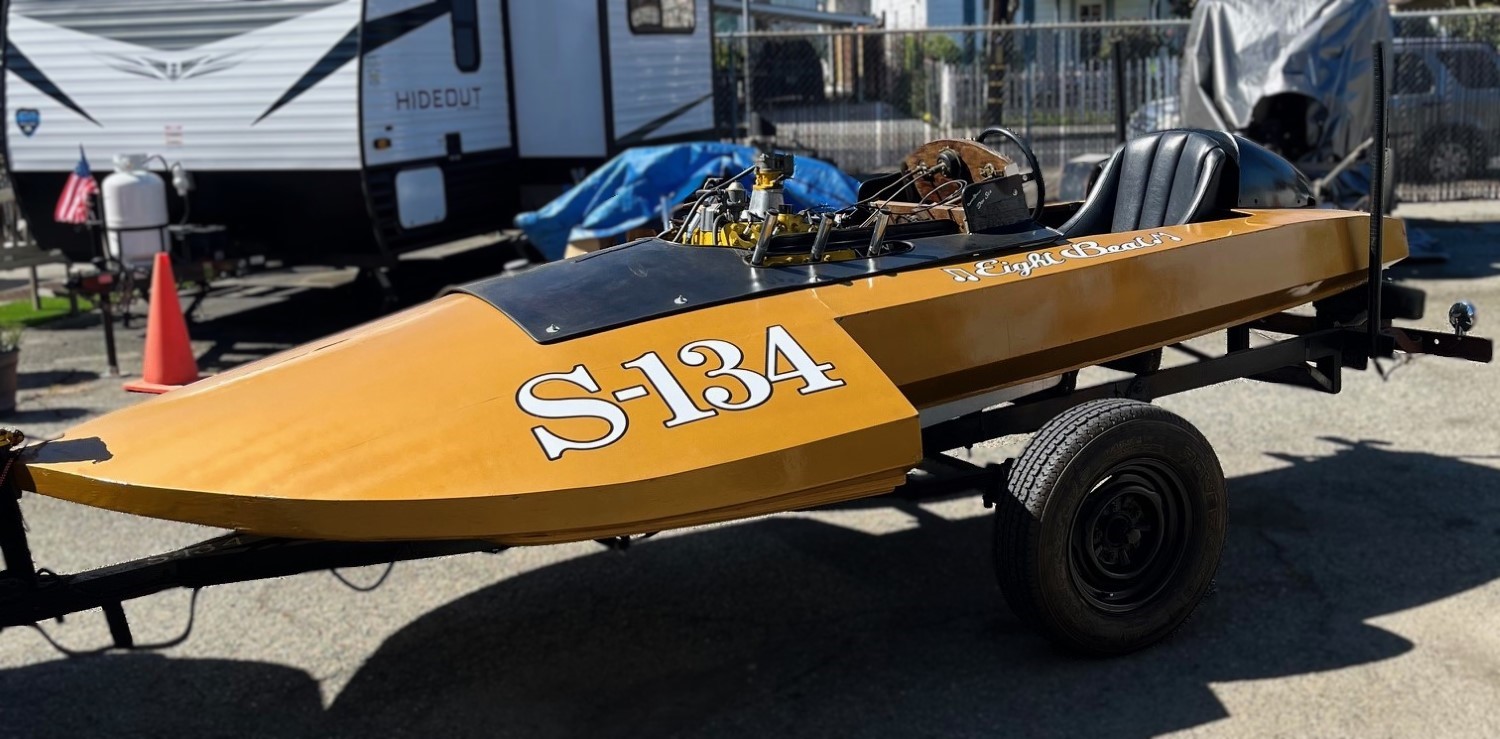
Eight
Beat S-134 was designed and built in
1946 in Alameda by Tommy Hill and was supposedly the
first three point hydro on the west coast.
She
is currently owned by George Smith of Pleasant Hill, California and he
is doing a full restoration. Above pic (and the next 2) are what she
looked like prior to George starting the restoration.
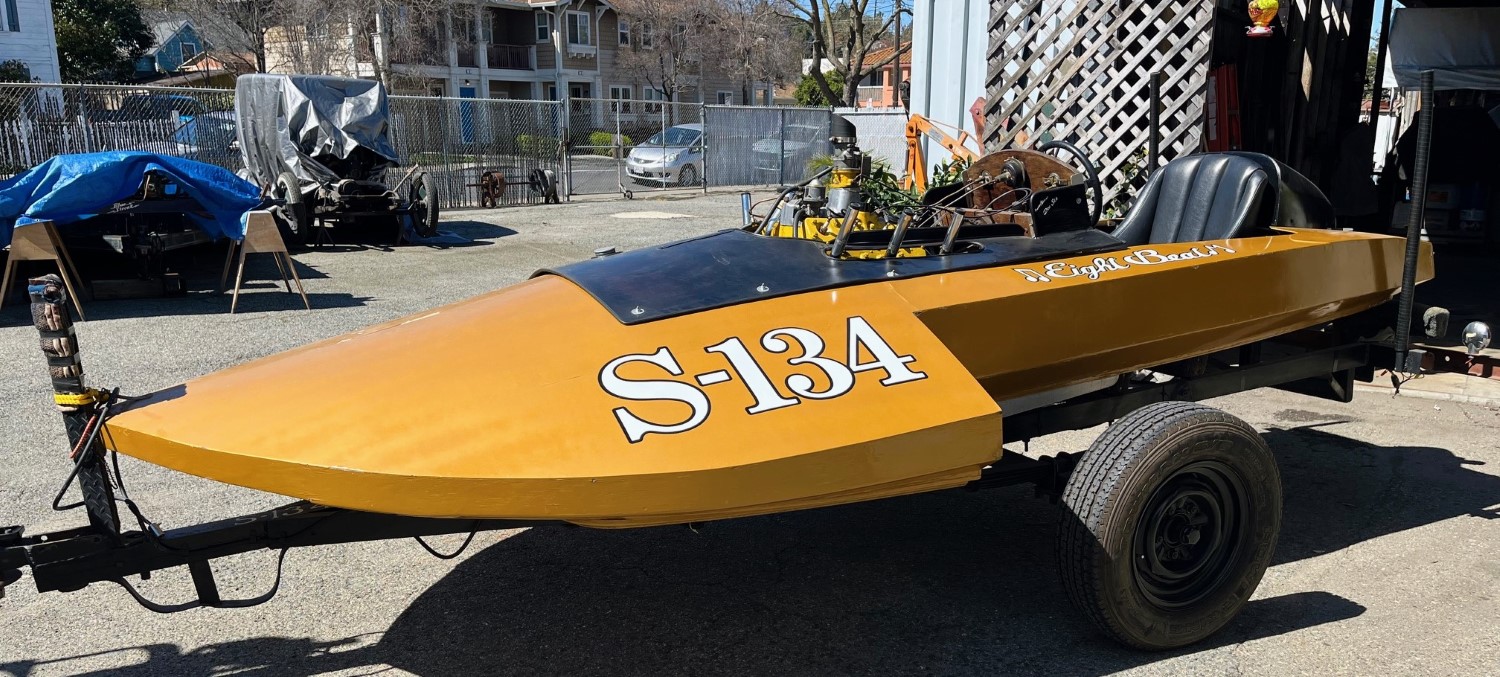
George acquired the hydro from Don Sea of Martinez,
California. "I knew he had this hydro but getting to see it was like
pulling teeth. He finally agreed to let me have a looksee and after the
visit to the storage locker he offered it to me at what seemed like a
great price. He must have seen the gleam in my eyes. The boat had been
sitting since 1982, so now, a complete redo is in order".
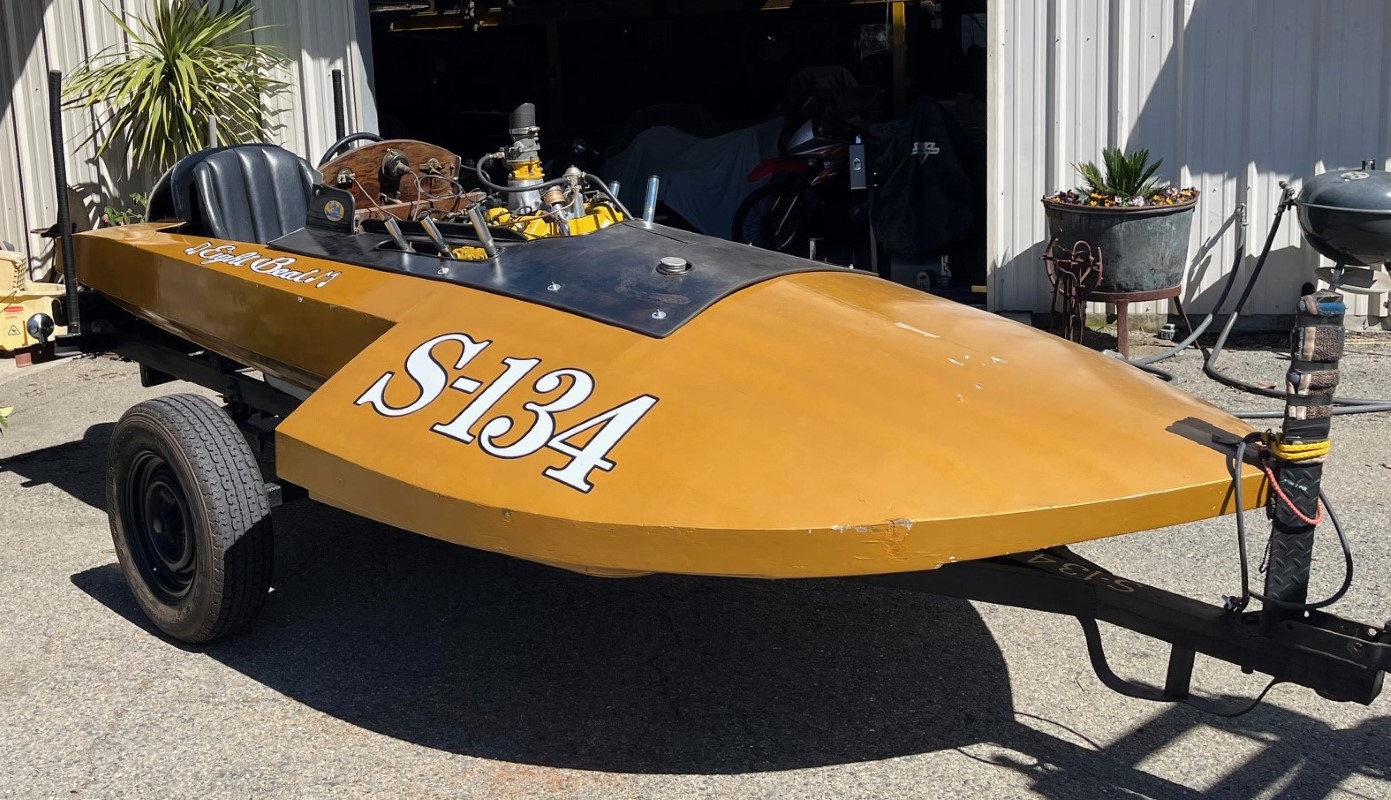
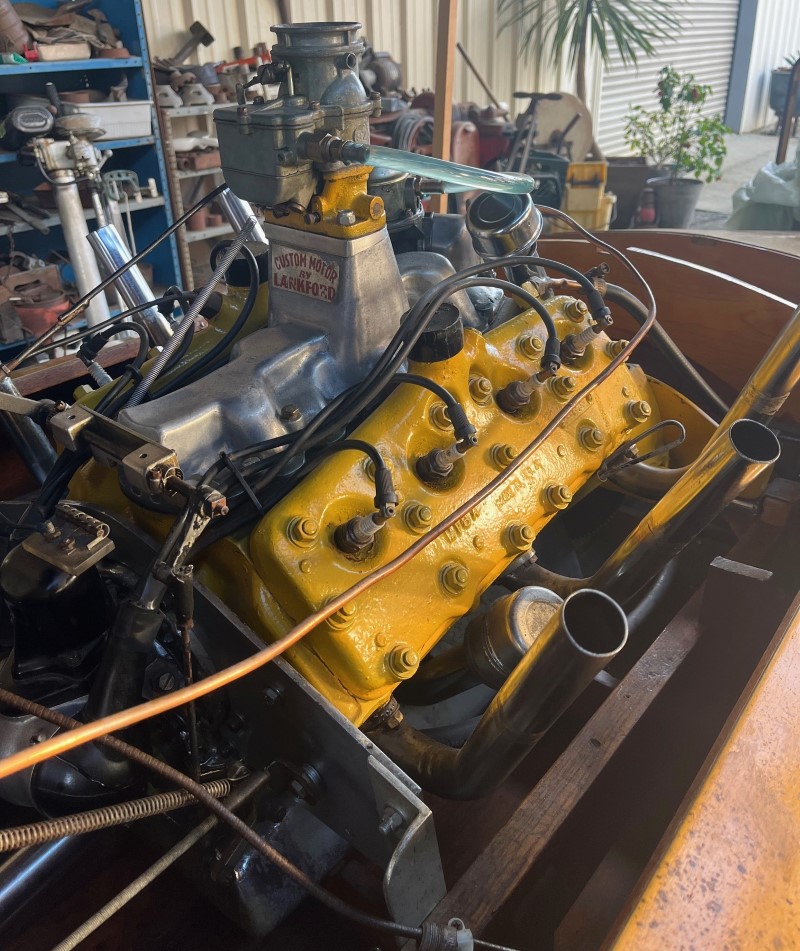
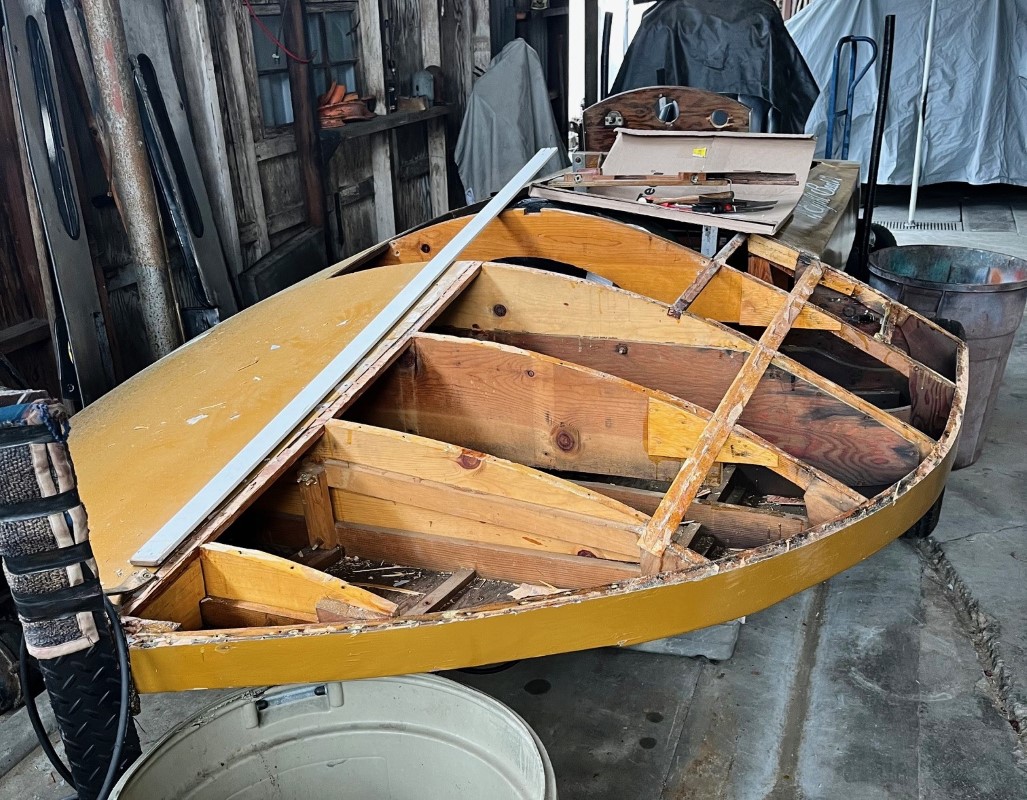
"When I picked up the boat I had mentioned to Don that I had
plans to re-sheet the deck and he said no need, that he had just done
it (???)
Well, the deck had a million screws and brass ring shank
nails holding it together. All of the longitudinal ribs were assorted
pieces of old furniture and scrap wood. Pieces of the ribs were hacked
out to make clearance for the steering cables. Once I saw how that was
“restored“, it was a no brainer to check out the bottom. The top had
been painted while on the trailer so gold overspray on everything,
thru-hull fittings, steering gear and trailer. Vinyl lettering
topped off the restoration.
I think that the
bottom was original. The plywood was well gone. I think that
the plywood was original because it was all one piece -
13' 6". All of the fasteners were steel and had long since
been of any
structural use. Why steel screws, any boat builder knows that’s a no-
no? Shortage of brass during the war??? After
removing the
sheeting I drilled all the holes to a clean nominal size and
doweled all holes. The ribs and keel were in great shape with no rot!
(thank goodness) |
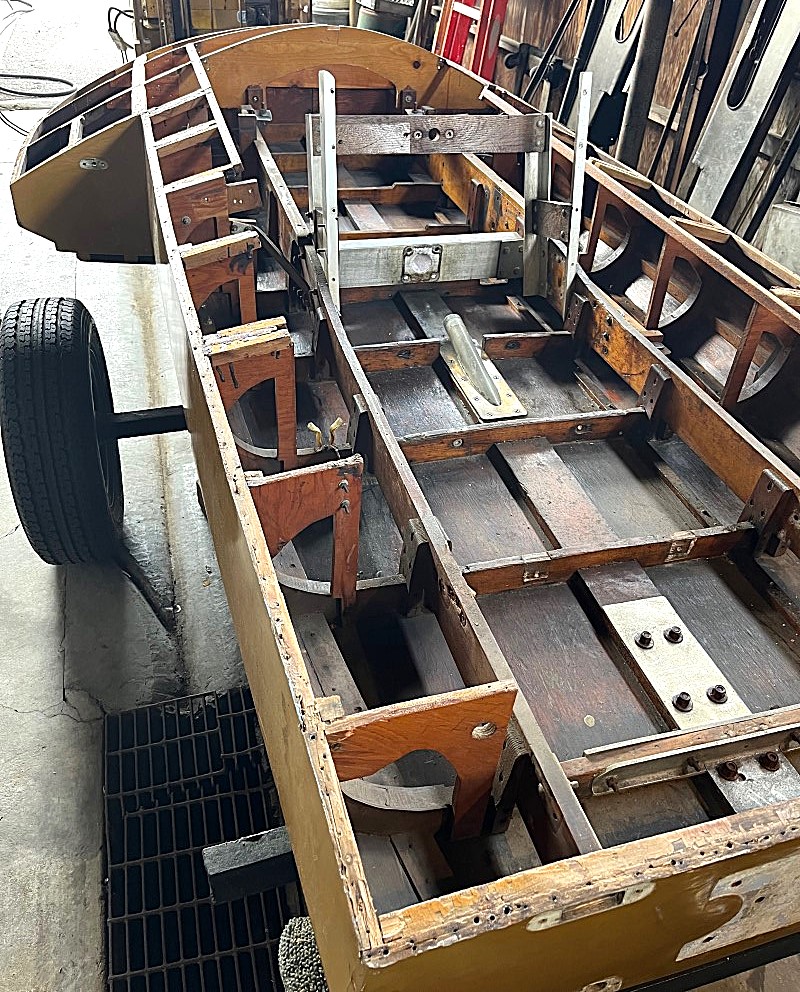
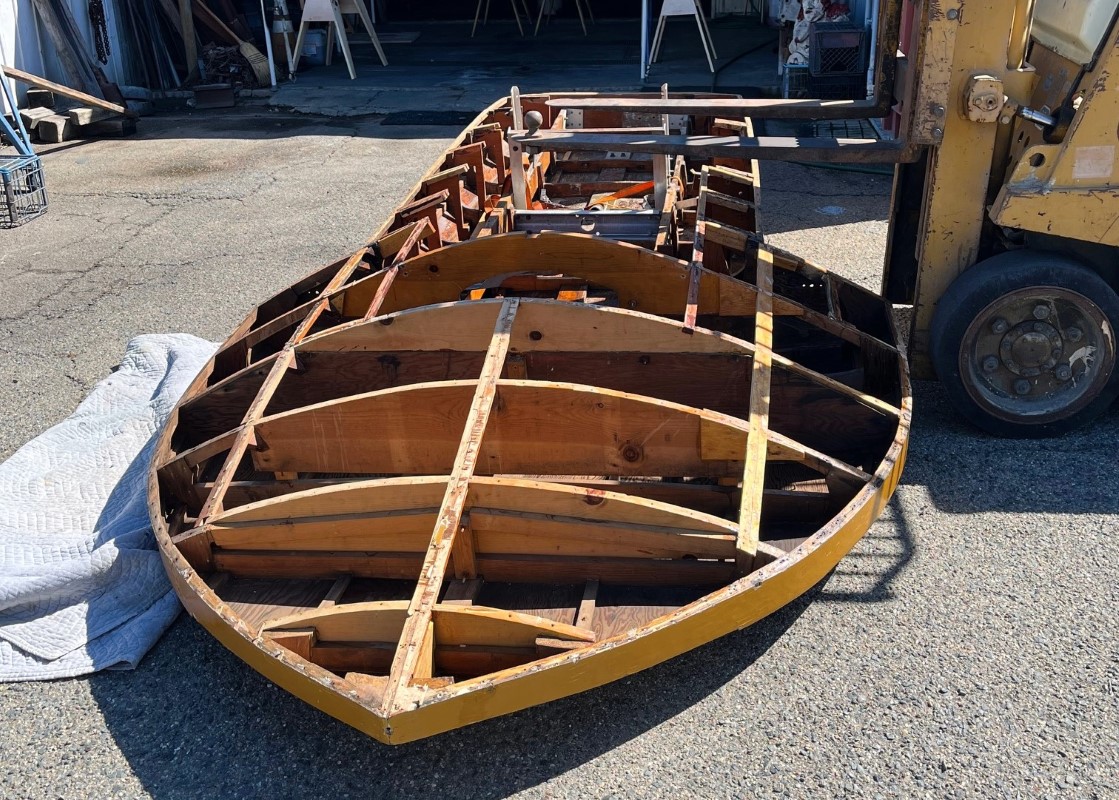
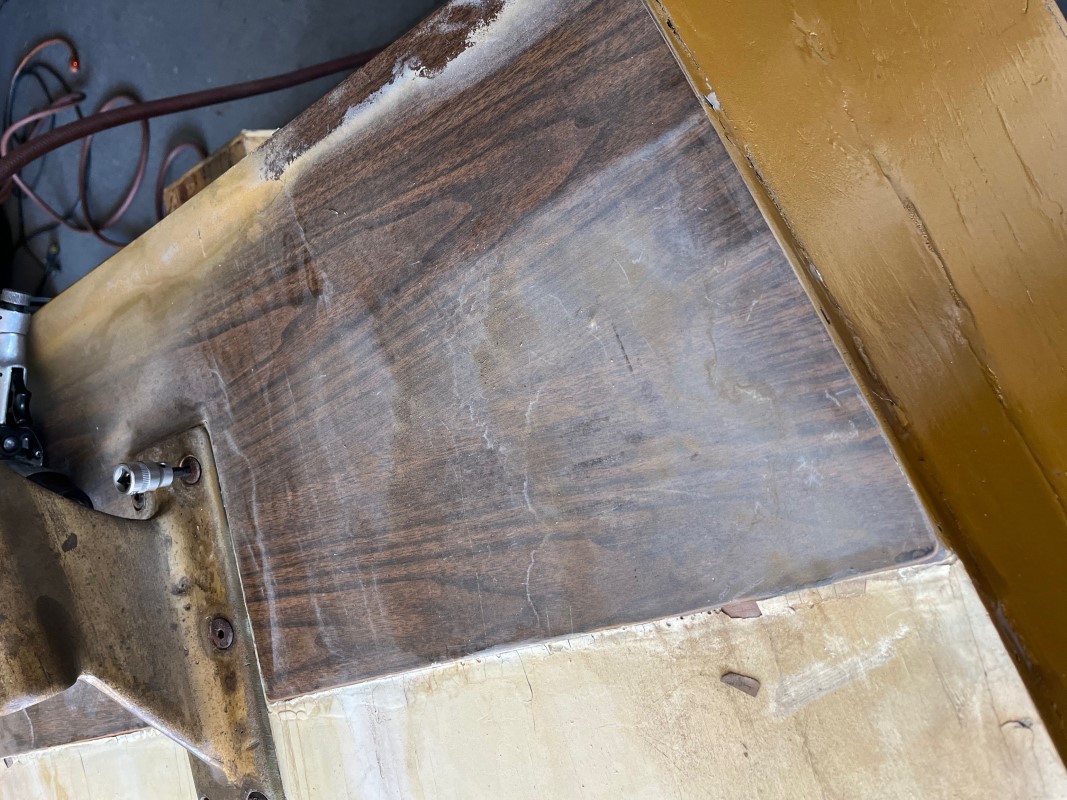
Threre was a Formica patch under the prop strut.
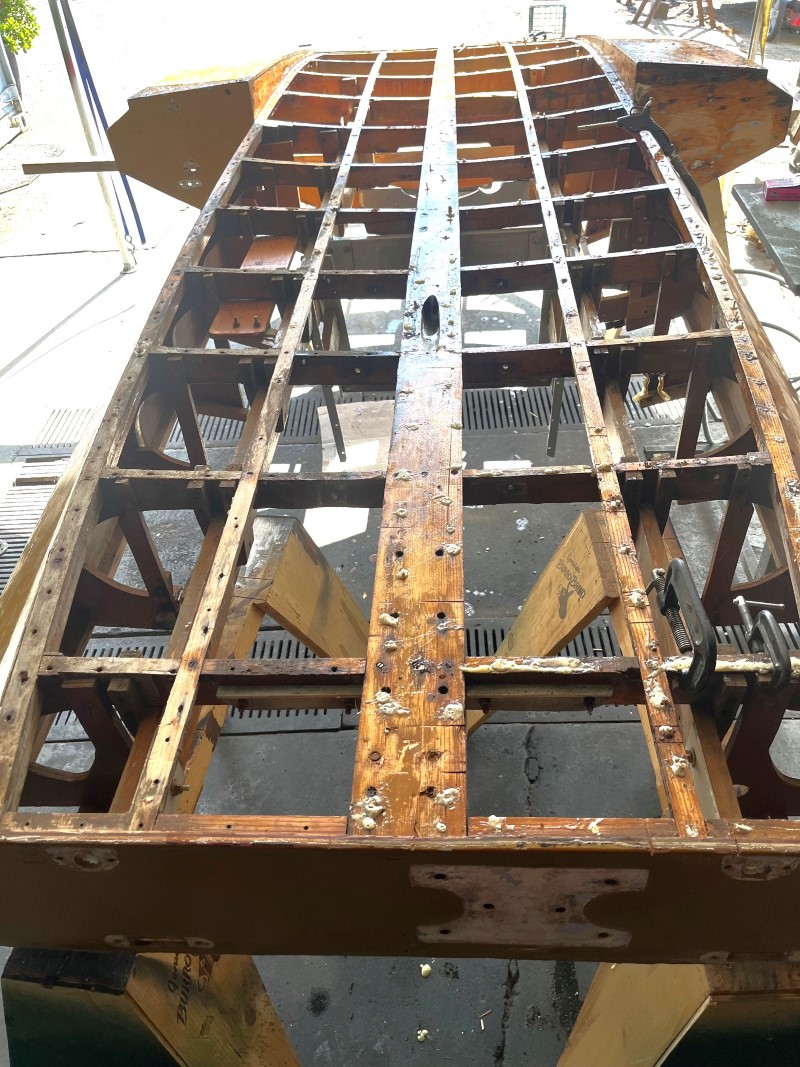
This Tommy Hill has an unique bottom shape.
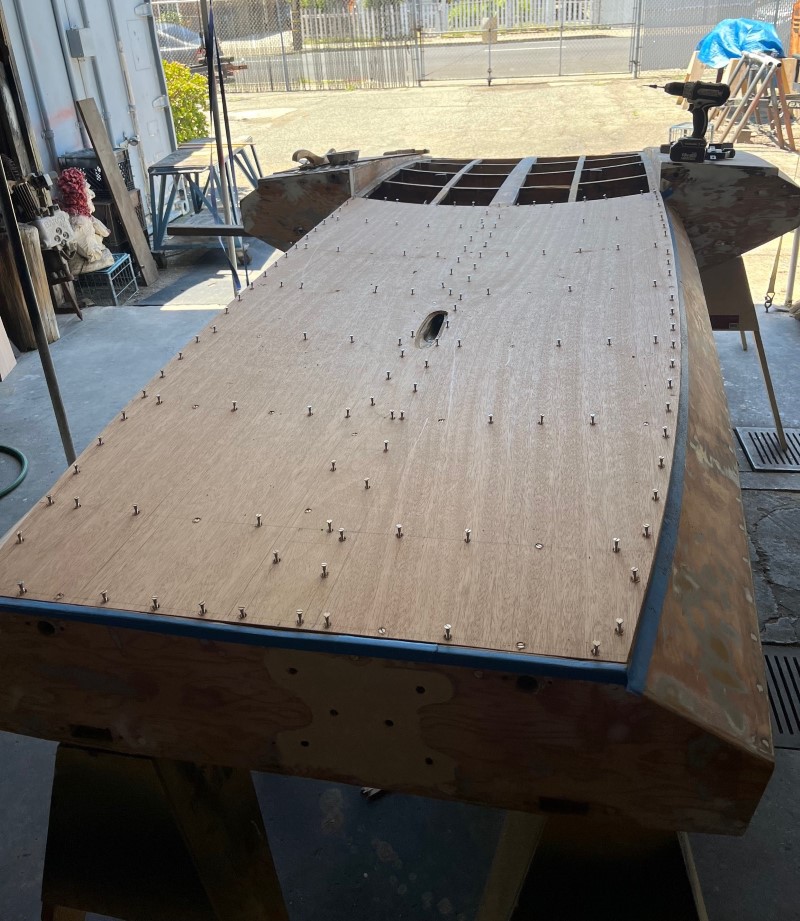
| The
plywood that I replaced the bottom with was 1/4 inch Mahogany marine
grade. I had to scarf the two pieces together since one 14'
piece of mahogany would cost about $800 delivered here. I made a
scarfing jig from an old battery saw and it worked perfectly. The
bottom sheets were glued and fastened with over 225 brass screws. I
used the West Systems epoxy and light cloth for the sides and bottom.
Two coats of epoxy primer and two coats of metallic Acrylic enamel. The
inside and deck needs most of the work but I don’t have to get on my
back, so all good. |
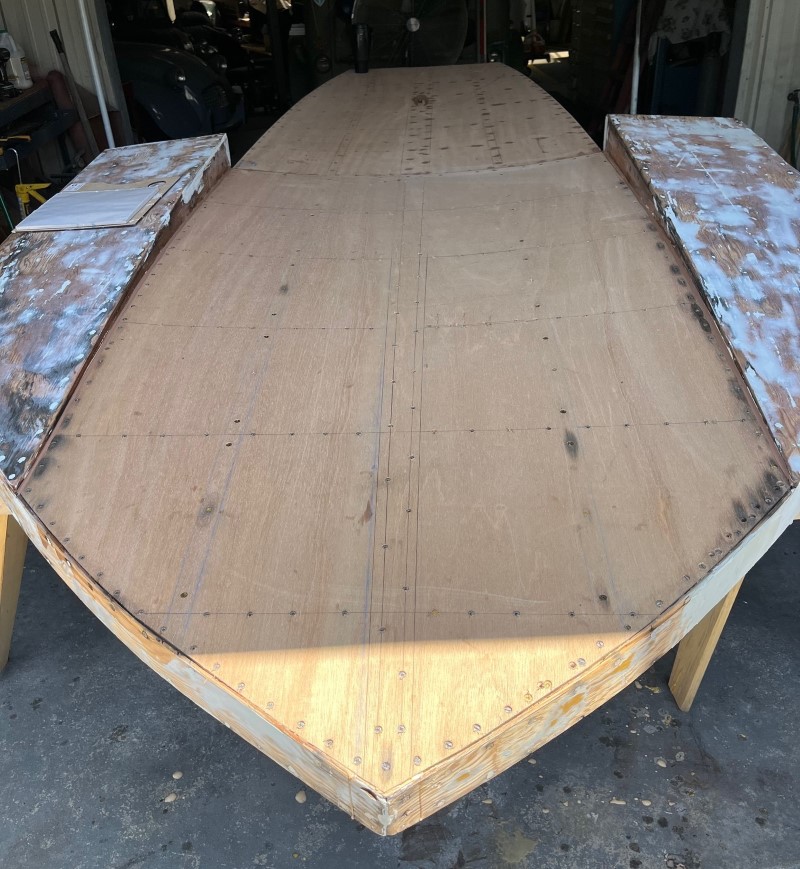
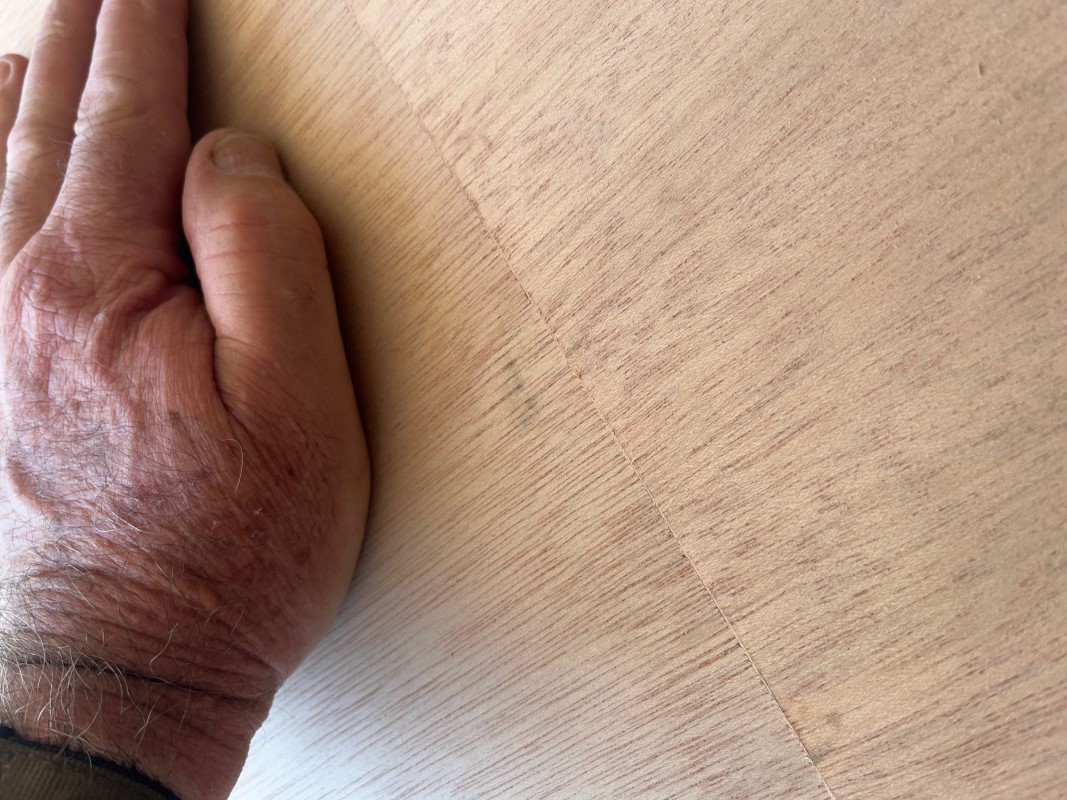
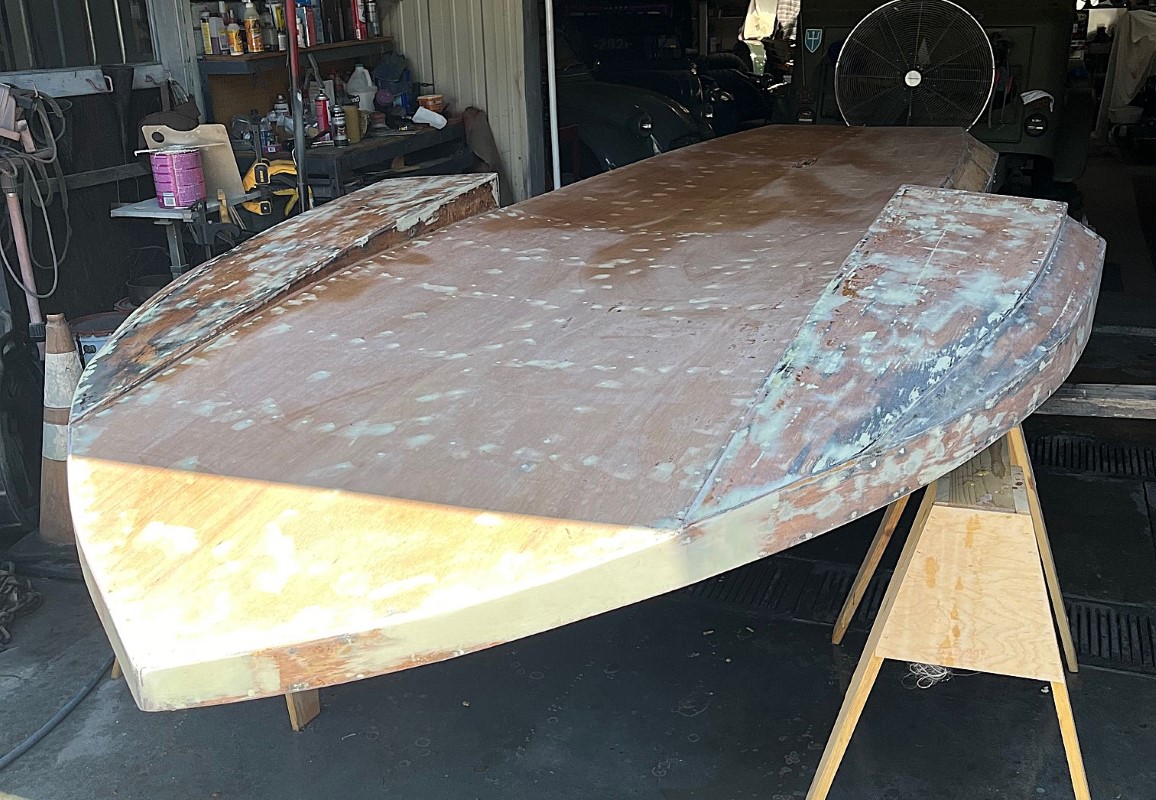
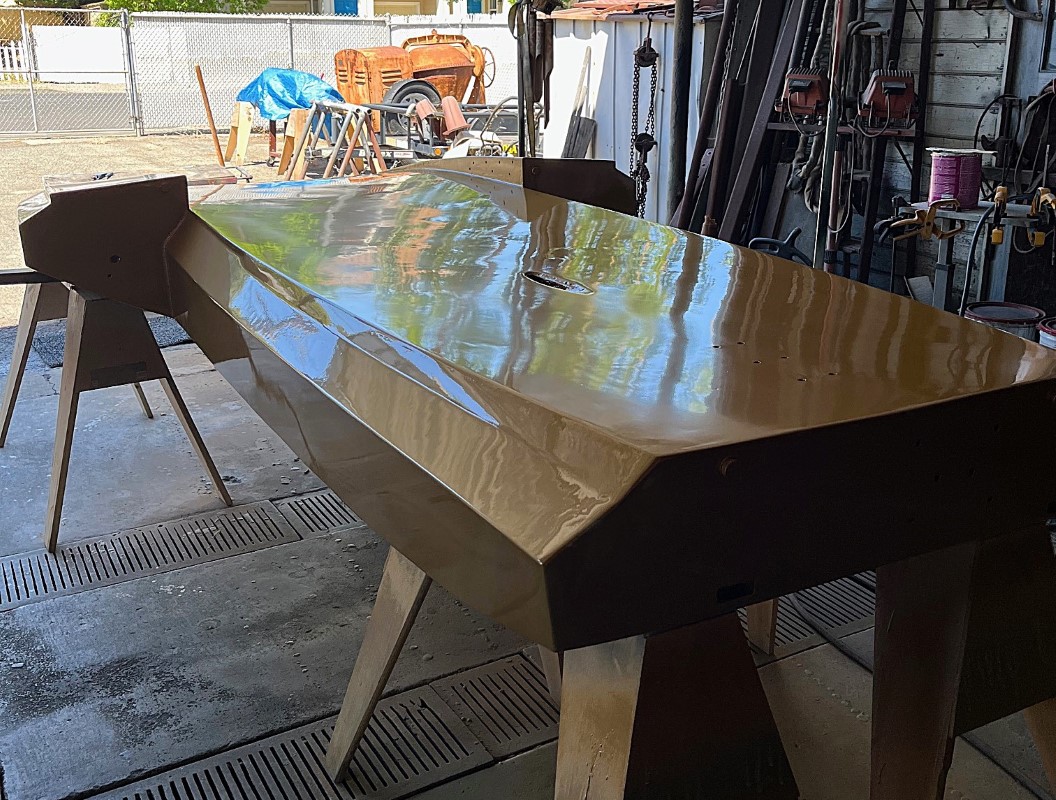
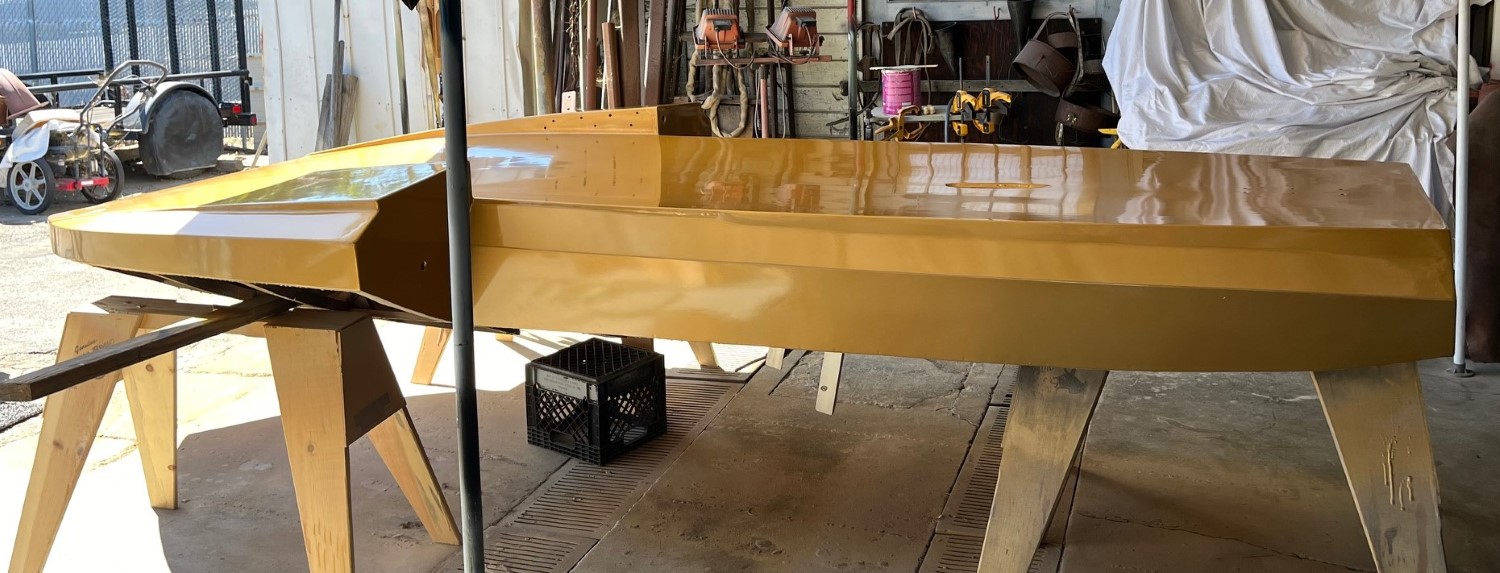
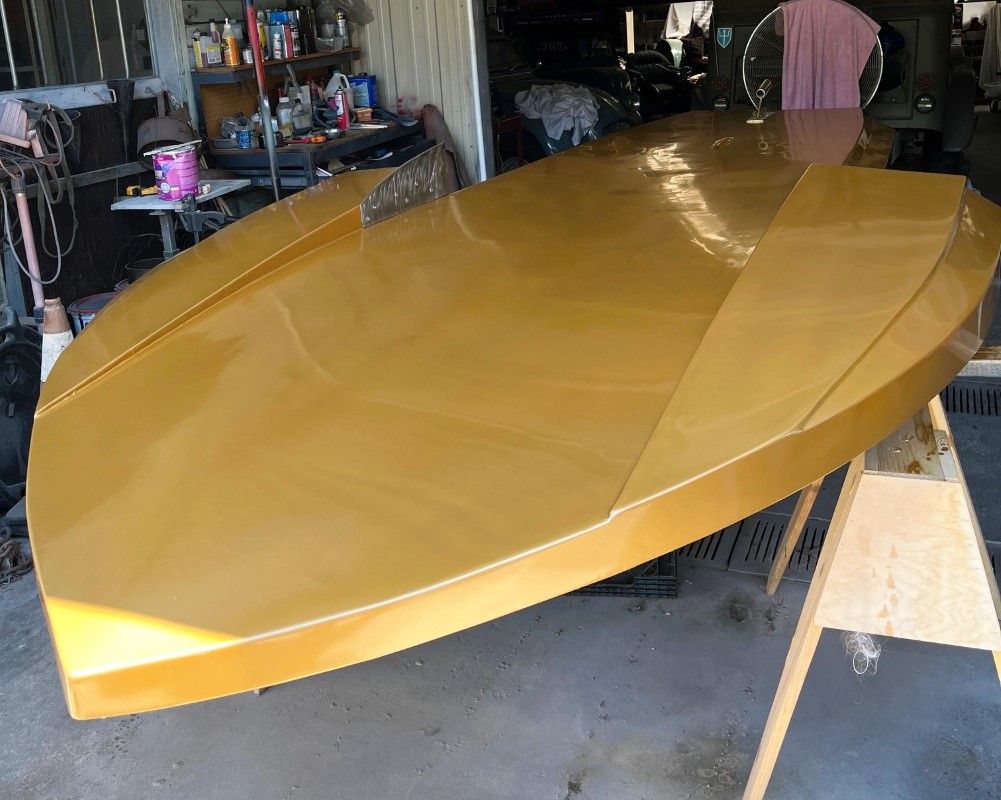
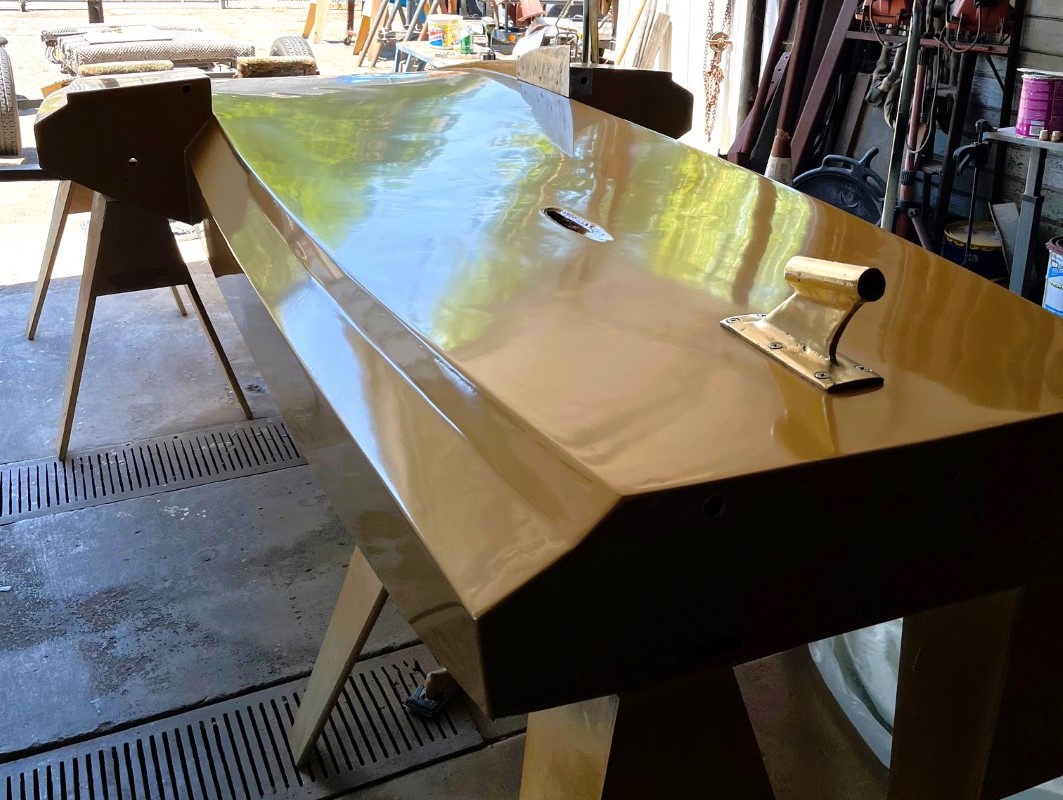
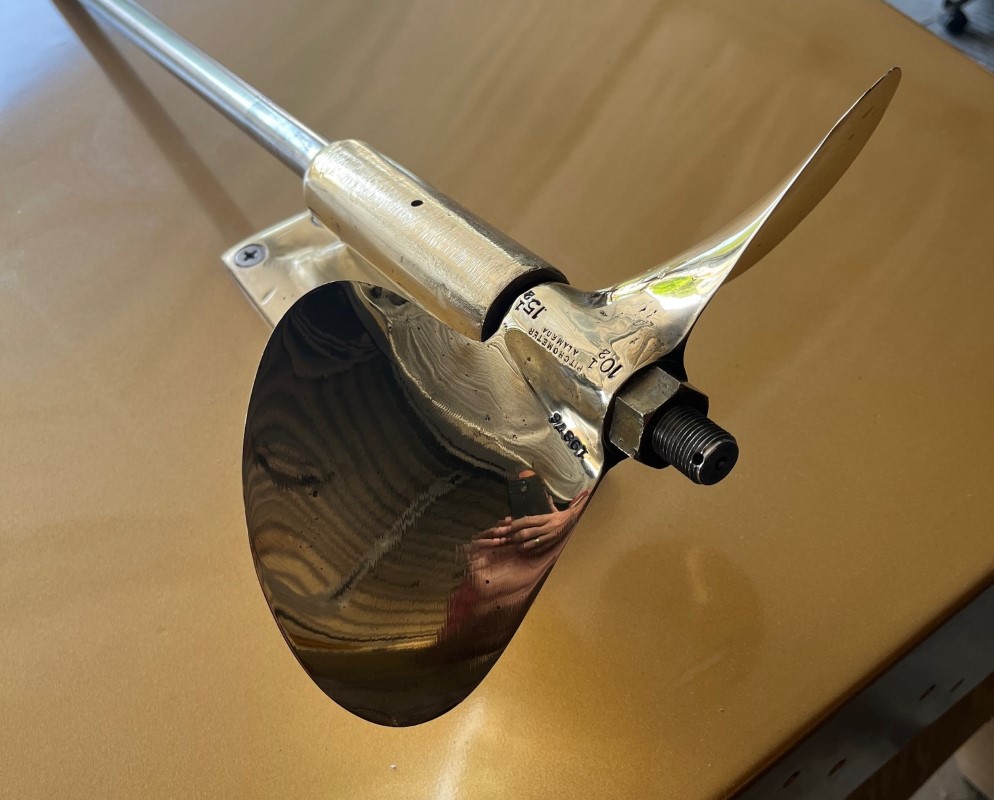

| All
of the ribs in the front of the boat were pine and oak. I didn't have
to replace any of those, just sister a few of them to repair splits.
The ribs (chine to rails) were cut out of 5/8" plywood and connected to
the bottom with 1x4 Fir. The plywood ribs were all sistered on both
sides with 1x1 Mahogany. The deck stringers were all 1x1 Mahogany. The
long deck stringers were also Mahogany, however the front to rear
stringer on the left side was completely hacked out for steering gear
clearance? and the long stringer on the right looked like it took
several hits and was removed in about 5 pieces. So absolutely no
support for the deck, front-to-back on the inboard side. |
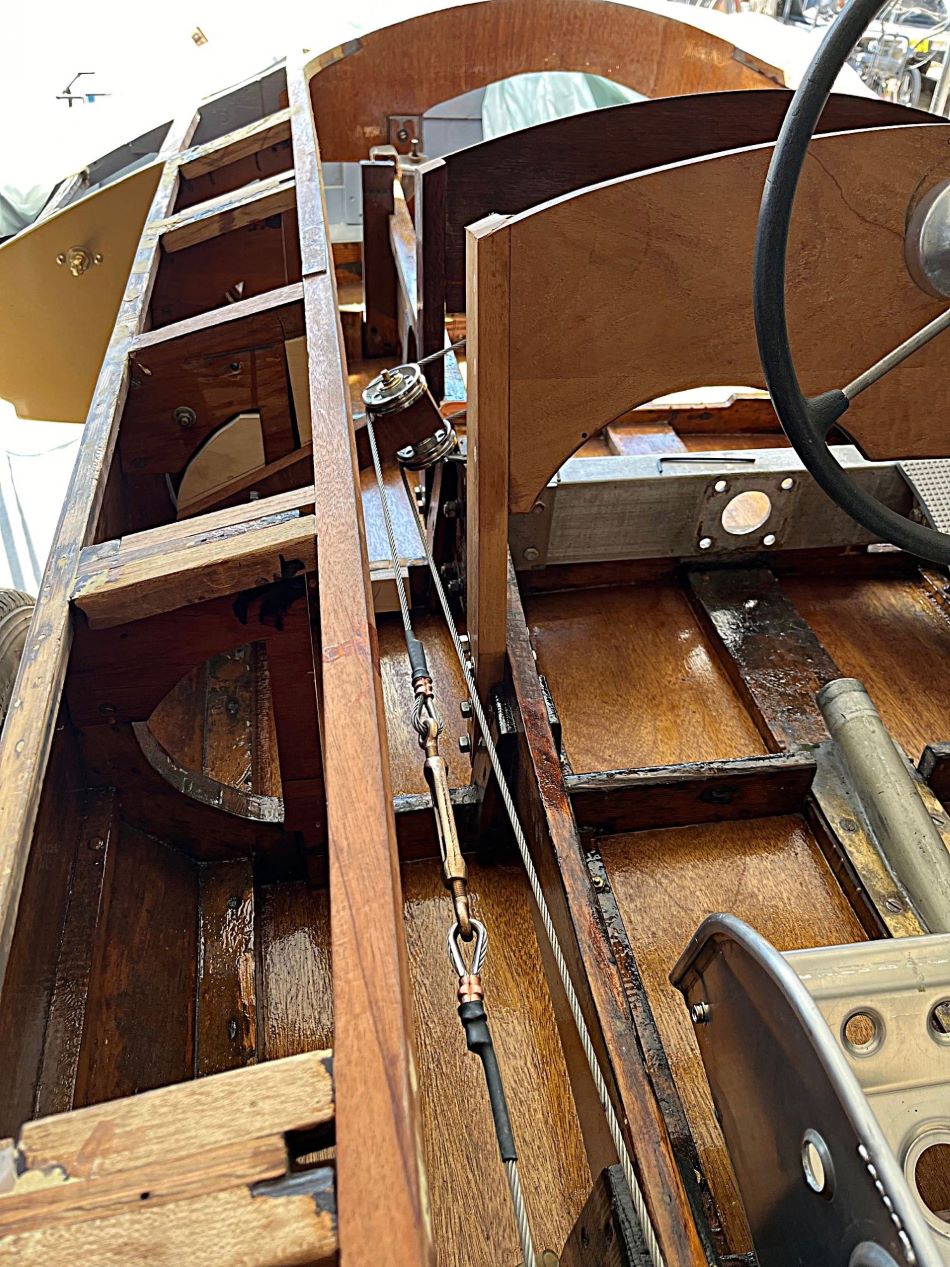
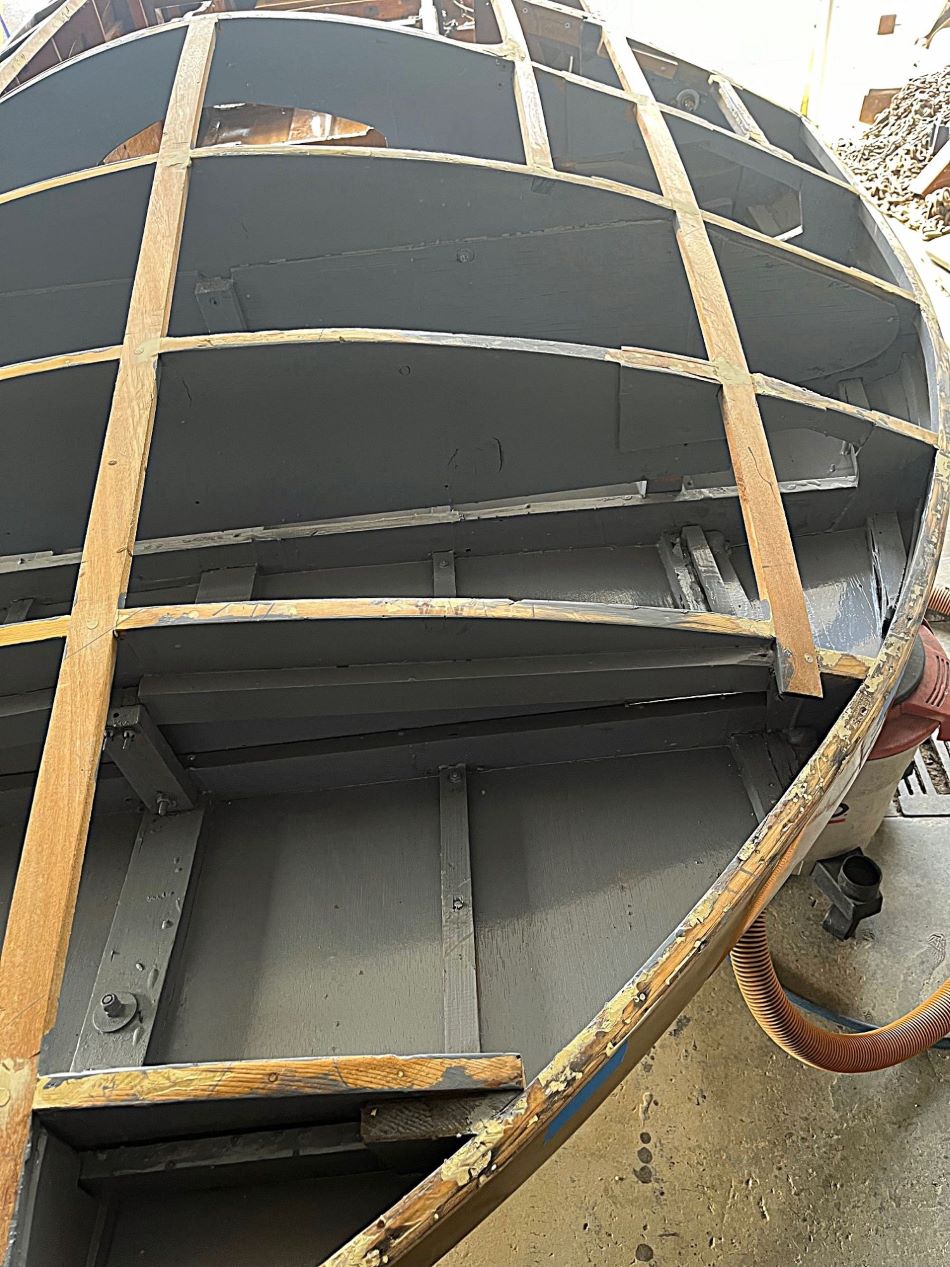
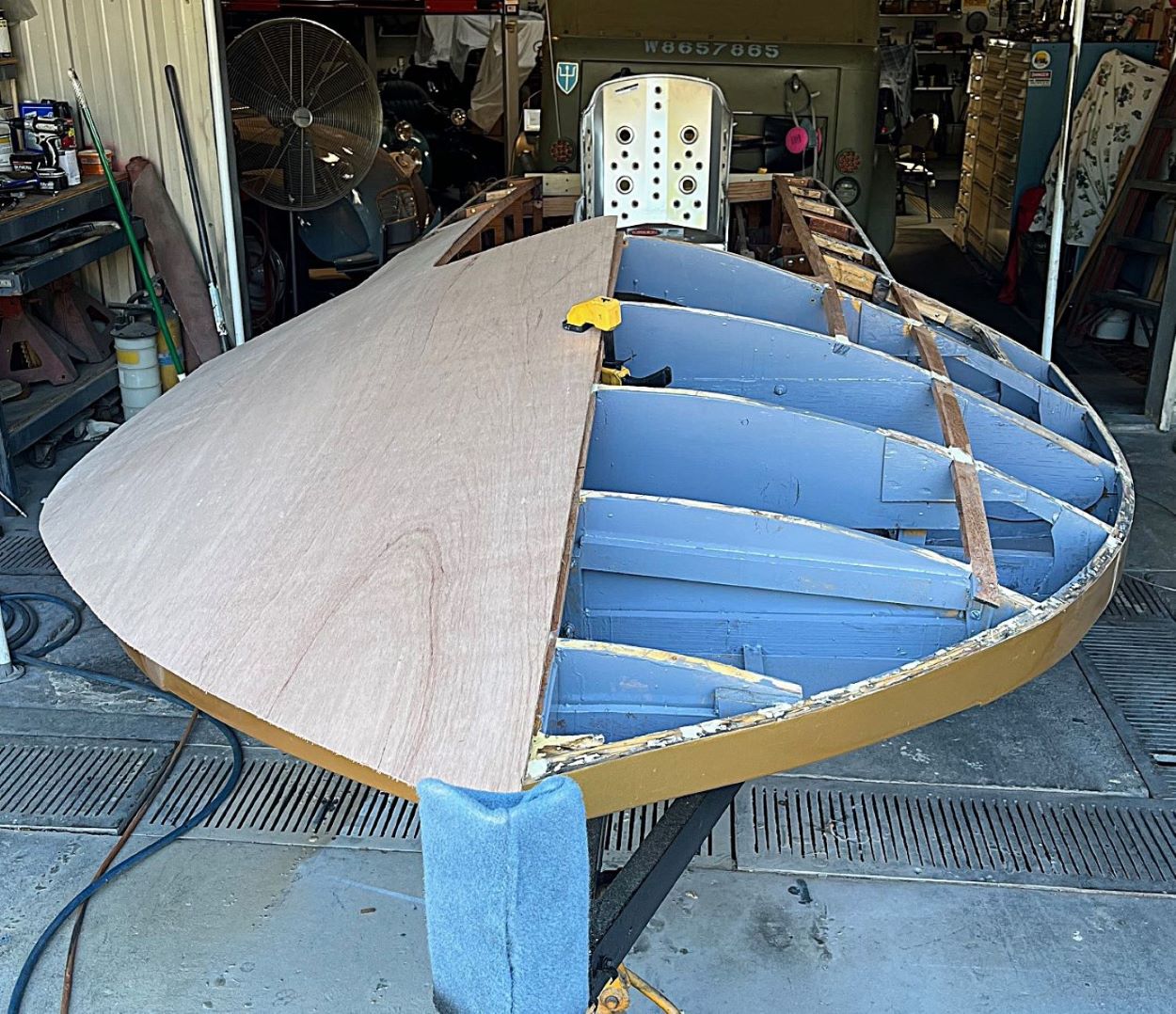
Newton
Moore, (Hayward, CA) is where I bought the first load of Mahogany and
all of the skin material, top and bottom.
The marine plywood is mfg’d by Wolstenholme
International, by TFT Wood experts, made in Indonesia, Meranti/Keruing
Mahogany
(commonly called Hydrotek).
Both the bottom (1/4) and top (1/8) are both from
this manufacturer.
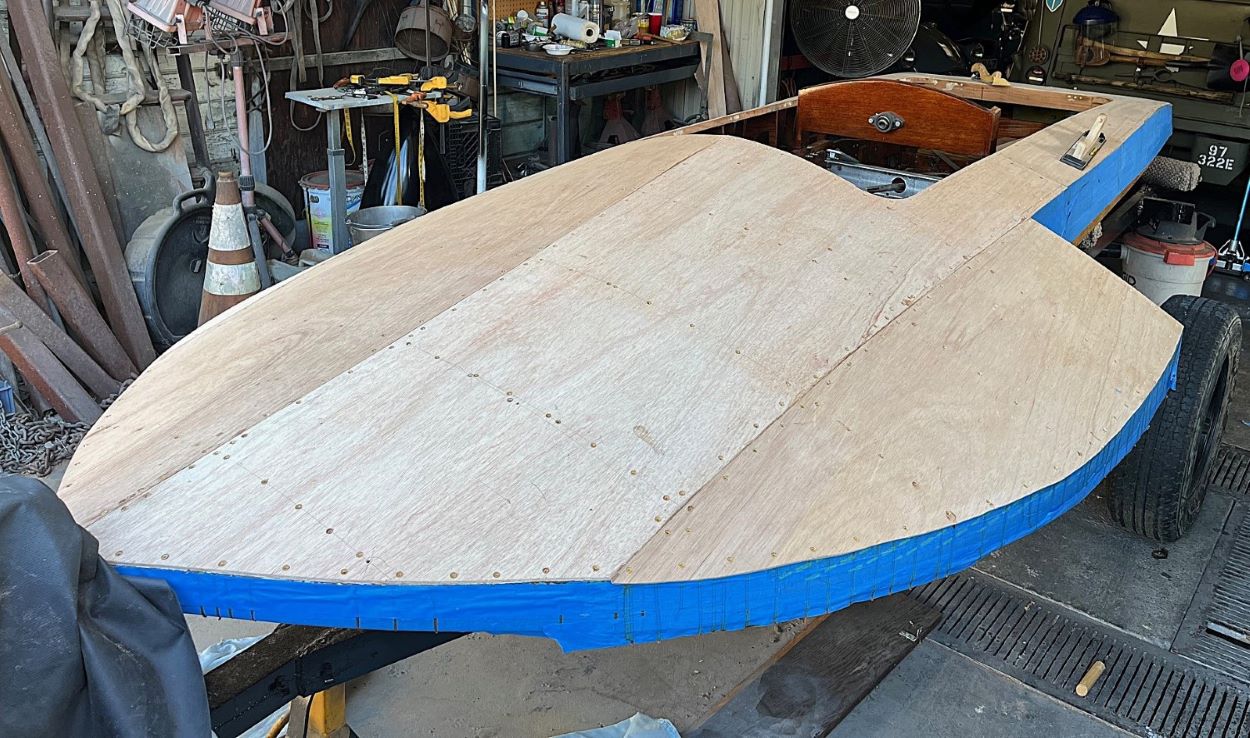
| The
boat now has a new deck installed. My thoughts were to use two
pieces of 4x8 ply and split the seam down the center. I spent a lot of
time fitting and making sure that the grain on the wood would mirror
itself. My plan was to clear the deck but I soon realised the ply would
not take the kind of compound bend that I wanted it to. Damn! So the
idea of a clear deck finish was out the door. So now the project at
hand is filling and sealing all of the joints and screw holes
(lots of
them). |
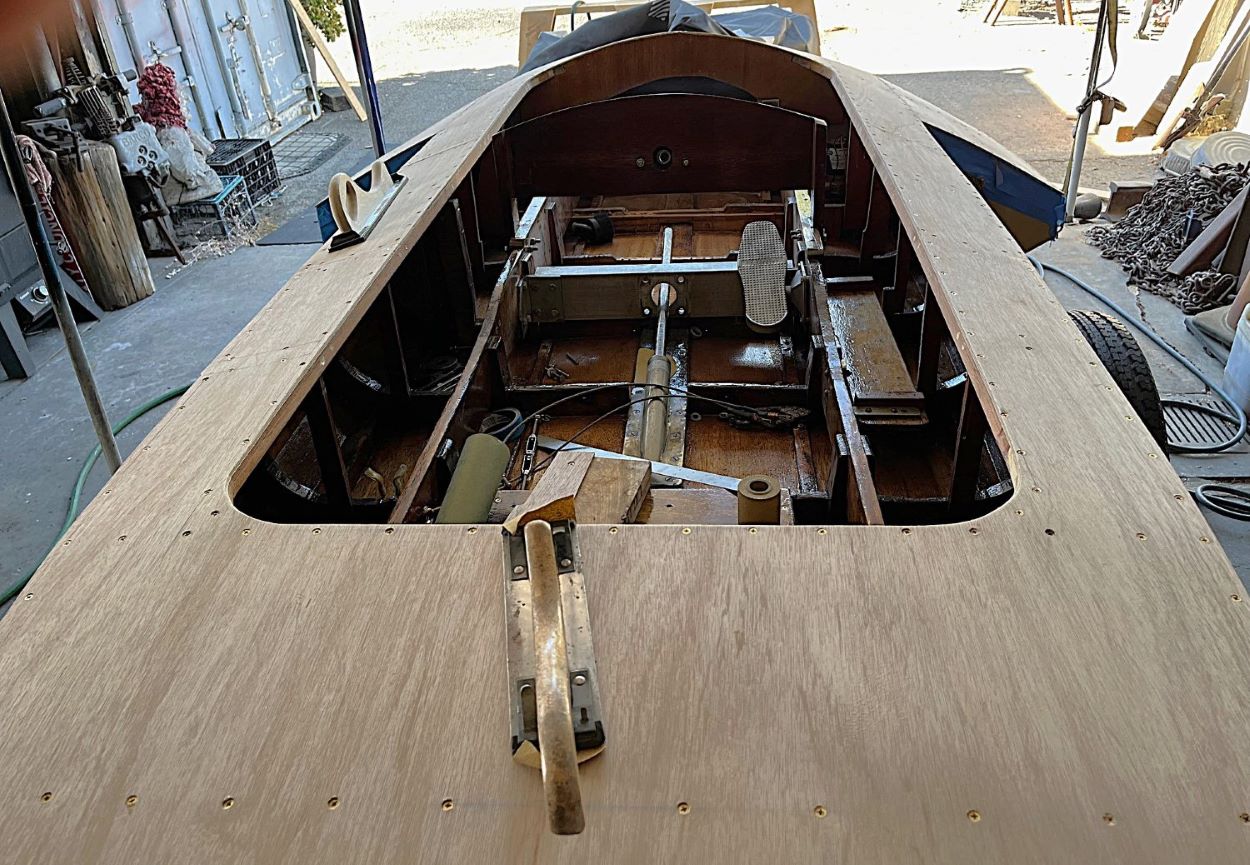
| There
are only two marine wood suppliers left in the S.F. Bay area. The
supplier in Berkeley, MacBEATH Hardwood, has been around for as long as
I can
remember in the same location. The other place is about 30 miles
south in Hayward. They are a new company but have huge buildings with a
small army of fork trucks. I think that they cater to the commercial
trade. The second load of Mahogany I got from the place in Berkeley,
when
I asked the guy where the Mahogany pile was, his reply was "like
Mahogany Mahogany?" so I knew then I was going to get schooled. So, I
said yes real Mahogany. I was escorted to a different corner of the
building where all of the wood in there was covered and fans blowing
everywhere. I began picking out a few 8-10’ foot long boards, all rough
cut 1x4s and 1x6s. The first thing that I noticed was the wood was way
heavier than the wood that I got at the place in Hayward. The next
thing that I noticed was the grain in the wood WOW! You can really see
the grain in the dashboard. I think that the difference in the color of
wood was the origin of the wood and some of the pieces that were left
out in the sun bleached out quickly. There was a lot of the short deck
stringers 8" long, inboard to outboard were originally Mahogany and
still salvageable but they look almost like Balsa with their age. |
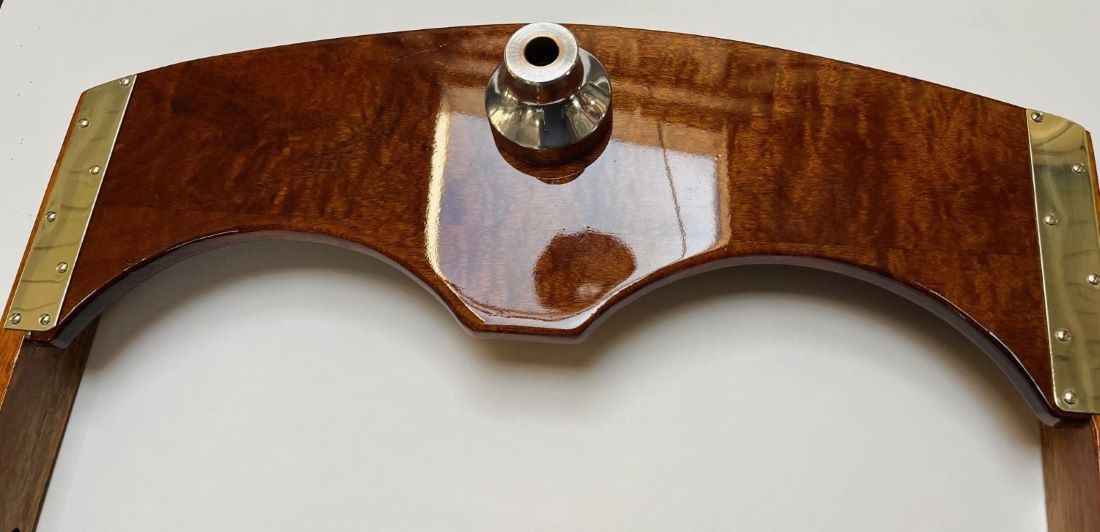
Dashboard
Things
are progressing nicely however very slowly. I work on the boat
everyday, sometimes all day. I'm not used to the waiting in between
tasks.
The steering has been reconfigured so that there is no binding and all
of the pulleys and cables are out of harm's way.
The new dashboard is
done along with the new forward steering shaft
support.
I’m loving the history of the boat. I found out that the boat
also raced at the Salton Sea, a long ago resort lake in the So. Cal
desert. A local boat guy said he has a picture of the boat while
racing that was in the early 1950s. Just putting that boat in
the
Salton Sea would explain the nasty corrosion on all the fittings.
Well,
this isn’t my first rodeo with old stuff, you just can’t expect
anything to be salvaged, and when you do it’s a bonus. |
© George Smith
Back to the boats
|


























